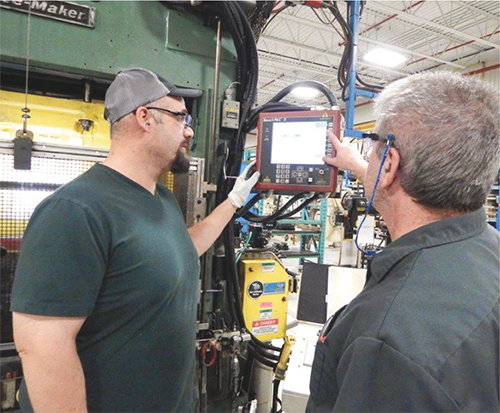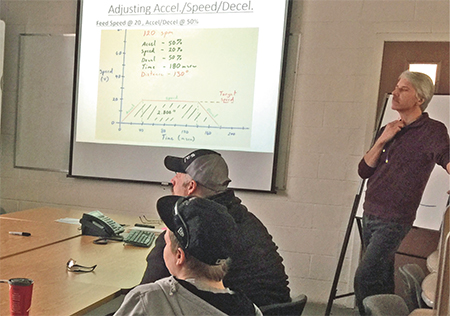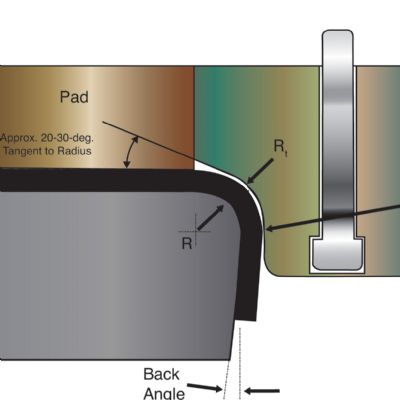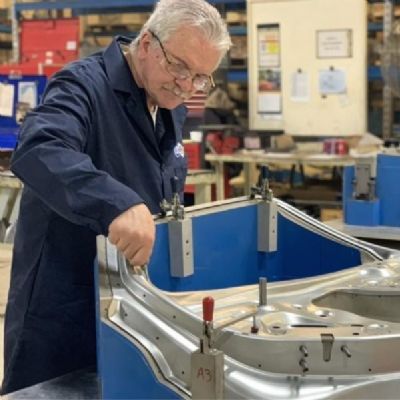A Skills-Training Academy
Finding skilled manufacturing help is a challenge throughout the United States and Canada, as baby boomers retire with few if any new replacement employees being formally and thoroughly trained on the requisite retiring skills. And, Larsen & Shaw is no exception. To address this concern, the company created an internal school to grow its own manufacturing talent from within.
“As a well-established family-owned company with a very dedicated, rural workforce,” Bushell says, “we lacked a formal technical training program for much of our history. The management team viewed this as a major threat to our ongoing sustainability. So, in 2011 we began to invest heavily in training.
“We’ve built 11 core modules and half of a dozen (and counting) advanced technical-training modules,” she continues. “And, we supplemented these modules with other training systems available in the market, including the Precision Metalforming Association’s OnBoardingME program, which we use to orient new hires into the world of manufacturing. Our training includes a wide variety of delivery methods, including self-study, classroom and online, and includes shop-floor hands-on competency assessments.”
The sensor program and formal training system at Larsen & Shaw both represent significant investments for the company. The benefits of the sensor program are, perhaps, obvious: increased machine uptime, minimized tooling damage, less scrap and improved better part quality and consistency. When it comes to training, Bushell says, “the benefits of training may be questionable to some, but not to us. In the past, this was a serious deficiency that would have eventually threatened the ongoing success of the company. The time and money that we have invested on the internal development of critical educational materials, the purchase of third-party training programs, and having a dedicated trainer (our most experienced technical resource), as well as dedicating time for other people to create educational material and to teach, is the only way to ensure that we develop the necessary skills needed to ensure long-term success. What could be more important than that?”
It is fair to say that for the vast majority of the company’s history, training was a serious weakness. Within the last few years, it has turned it into a strength, “which helps me sleep much better at night,” Bushell adds.
The Critical Role of ERP Software
The proper selection of manufacturing employees is more important than ever as various computer technologies become mainstream on the manufacturing floor. Finding truly trainable metalforming and assembly employees can prove difficult for many companies. At Larsen & Shaw, a new ERP system helps overcome this ongoing challenge.
“We have developed a robust candidate-screening process, orientation and technical-training programs,” Bushell says. “And, we have tied it all together with the help of our ERP system (Plex, implemented in January 2015). With Plex, for example, we can document for any given position the various steps in the required training plan, using a work-flow process. This provides online visibility of an employee’s progression through the plan, and allows us to provide assistance when necessary.
“Training materials store neatly online as well,” Bushell continues, “for ease of access by the trainer and as ongoing references for employees. We maintain formal training records within Plex as well, so supervisors can quickly and easily verify which operators have been adequately trained for a particular job. Throughout the manufacturing floor, all employees are fully versed and totally engaged with the ERP system.”
Employee Comments
I often ask shop-floor workers and managers to share their thoughts on their employer’s progress toward worldclass manufacturing. Here are some observations from various employees at Larsen & Shaw.
- “The training is good. It gives me a basic understanding of how the line works…what is happening beyond just the numbers I am entering. It is like starting and stopping a car—a lot is happening behind the scenes and it is good to understand that.”
- “I picked up a few pointers. I realized immediately after the training that I did not have my feeder set to the optimal speed for the line, so I made the adjustment and the line runs better as a result.”
- “The training was good. I made a change to the height of the roll release as a result, and set up a system to verify for other operators. I also learned about a feed-initiate adjustment that will allow quicker line startup.”
- “We have come a long way with still a long way to go. Seeing the engagement of the operators tells me it is time well spent. I believe that the success we are seeing lies with the operators who are open to learning and open to new technology that keeps us ahead of our competitors.”
- “Our training has grown in leaps and bounds. Total commitment would be the reason for this change. The current training is going great and the reason I say that is because of the on-the-floor response of the operators, which within hours of their training are actually putting their training into action and improving productivity and equipment efficiency. This is the ultimate of training success.” MF
See also: Tecknow Education Services, Inc.
Technologies: Management, Stamping Presses, Training











